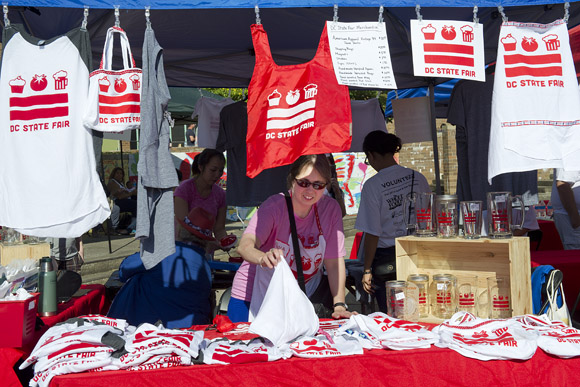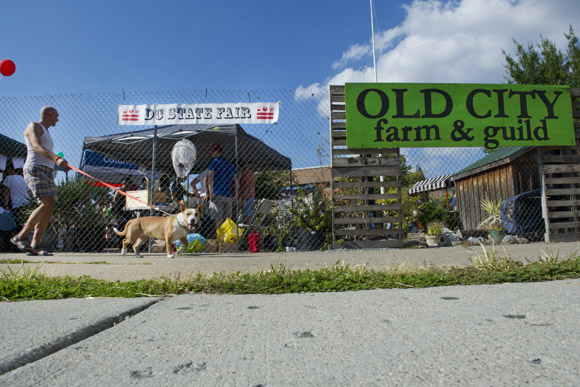D.C.'s homegrown, DIY "state" fair, held Saturday, celebrated all there is to celebrate about urban gardening and food production in the city.
When local chef
Matt Finarelli got the phone call asking if he'd help judge pickles for this year's
D.C. State Fair, he was confused. "D.C.'s not a state yet, so how can they have a fair?"
Newcomers might be forgiven for being similarly confused. Walking through the entry gates last Sunday under a printed sign announcing the Fair, visitors weren't greeted by funhouse rides, Ferris wheels or the smell of funnel cakes. Instead, the tiny makeshift fairground in Shaw was packed with baked goods, canned foods, fresh vegetables, and urban farmers with information tables. Less of a carnival and more of a garden party, this event aimed to show the rest of the world what the soil of D.C. can produce, both in the form of community and community farms.
At a table near the front entrance, a hand-drawn sign asked visitors not to touch the fruit and vegetable contest entries, which included: a neon green, porcupine-like bitter melon; several oddly shaped pumpkins; a hot pepper the size and shape of a large acorn; and a butternut squash with a face drawn on it and pieces of chain link fence embedded in its beige flesh.
Over at the table for knitted goods, a hat shaped like a pig and made for a newborn baby proudly displayed a first-place ribbon beside an entire 3-D landscape of knitted dinosaurs drinking from a prehistoric yarn pond, while on a shelf safely out of reach entries to the urban honey contest were lined up in jars of various shapes and sizes, glowing in the sun like amber-stained glass.
Around the corner, glasses, aprons, and placemats emblazoned with the Fair's logo -- a playful take on the D.C. flag with a cupcake, a tomato and a beer glass in place of the three stars – were for sale. T-shirts with the same logo were so popular that a crew of volunteers was called in to run a silkscreening station on site.
On stage a team of three judges sat stoically making their way through twenty pie samples, searching for the best crust, the best apple, the best savory and the best overall, while the baking contestants and their families sat and watched nervously from below. Competition for the first place pie was proving steep, and the stakes were high. Winners could potentially have their recipes featured at the P Street Whole Foods Market later in the year, as well as the possibility of getting time to pitch their baking talents to those higher up in the national company.
"People really love to be able to claim the blue ribbon prize," said D.C. Fair board member Christine Perez. "It is fun to be able to showcase talent in the district."
"Its very exciting to put this on and see all these people show up," said board president Amelia Showalter.

It was Showalter, griping online with other bloggers several years ago, who helped invent the Fair. She had produced some great tomatoes in her D.C. garden one summer, she recalls. She wanted to show them off and ranted about the lack of a fair in a blog she was writing. Others chimed in and insisted it should be done, despite having no statehood in place and no financial backing from an official within the city's administrative offices. Why wait for official statehood when the state of gardens in the city was already so impressive?
In the five years since they began, she and fellow organizers have continued to host the Fair and keep the enthusiasm growing as the number of urban farm projects and gardens has also grown around city. Run entirely by volunteers who all have demanding day jobs, it isn't always easy. "We run on a shoestring budget," Showalter said.
"This is the first year we haven't been a part of a neighborhood street festival. We are getting closer to going it on our own," Showalter added, although this year the event was paired with Homegrown DC -- a "hyper local farmer's market" offering small non-profits, community gardens, and D.C. urban farmers a space to talk to the public.
Those who visited the Homegrown DC area at the Fair, for example, could buy greens grown by children working at one of the City Blossoms gardens, or sample some tea made with their mint. Those who stopped by to talk to the staff from a nonprofit called Brainfood might sign up their teenager for a healthy cooking class. And anyone visiting the Wangari Gardens table was told about that garden's compost cooperative.

Such work has been increasing rapidly in the city since D.C. Mayor Gray's Sustainable DC Plan was put into effect in 2013, which included the ambitious goal of ensuring that 75% of the District's residents live within a quarter mile of a community garden, farmers' market, or healthy corner store by the year 2032. Progress, say critics, has been mixed. Trying to address urban agriculture without working on the bigger problems in the city's poorest neighborhoods is not ideal.
"Food deserts didn't just pop up overnight," said Ashanté Reese, a doctoral candidate at American University. "Food is not isolated from social policy." There are powerful, economic and political issues involved, too, she added. That said, while she thinks much of the country seems to be missing the mark on creating access to healthy food nationwide, D.C. is doing quite well.
For those actually getting their hands dirty in this city's non-profit food sector, it seems important to share personal enthusiasm and support. Growing alone is not half as fun as growing with others.
"Year on year, people are listening to the comments they get," said Toni Burnham, president of the D.C. Beekeepers Alliance and one of this year's three honey judges. "The State Fair is functioning for us as a really valuable educational opportunity. What we do here is the same as honey judging done all over the world. It is meant to help our beekeepers be practicing at the same level. This what gives us the chance."